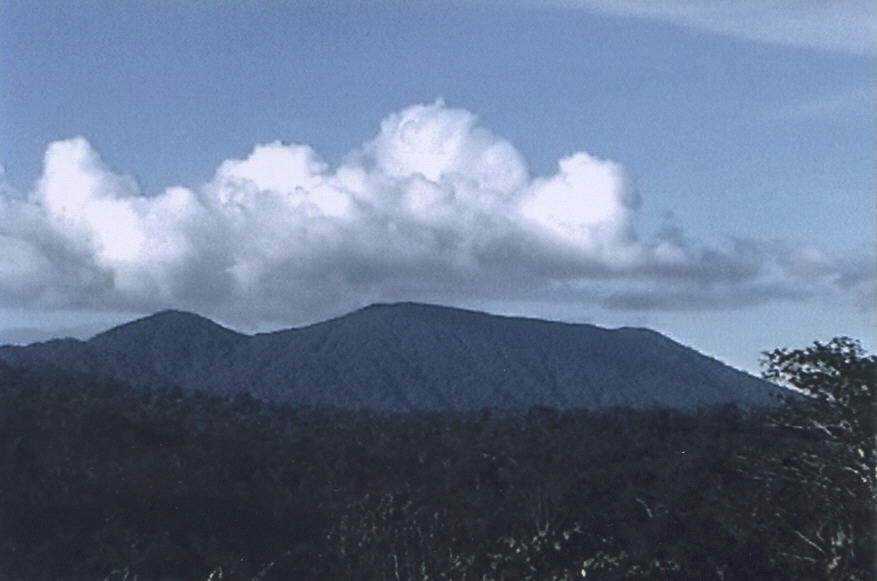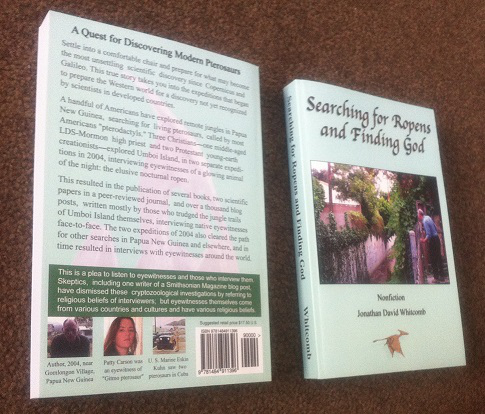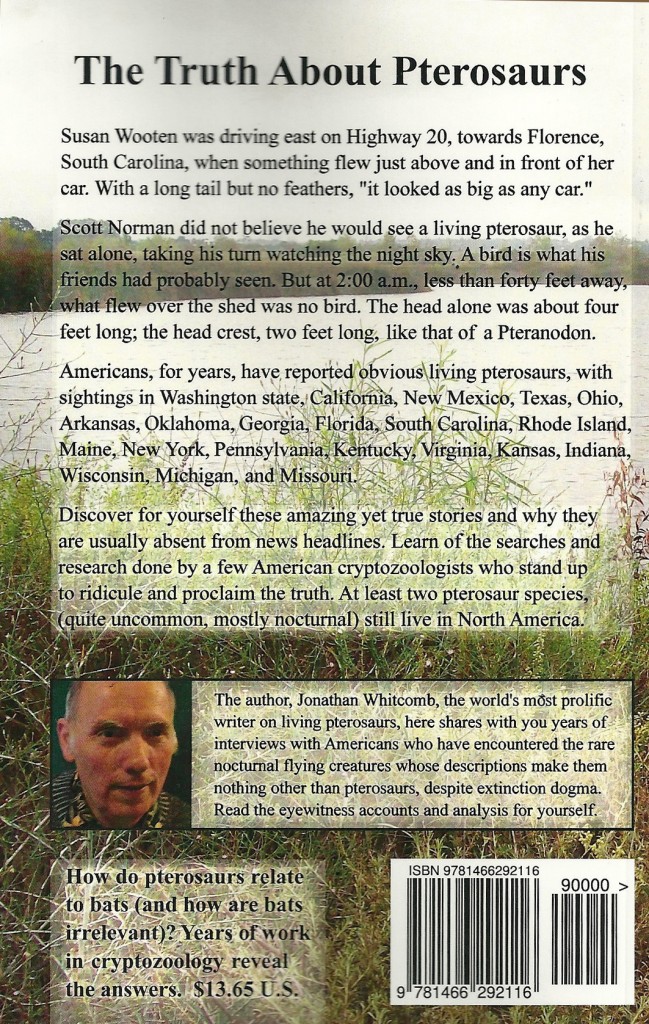This requires an introduction to eyewitness testimony and this concept: that many professors have been entirely mistaken, for generations, about what could be called the “universal extinction of pterosaurs“ assumption.
[This introduction has become much longer than what I had intended originally: to explain a narrow focus in an analysis meant to judge how much the passage of time may have affected specific descriptions in eyewitness reports of living pterosaurs. For those not needing any introduction to cryptozoological research into eyewitness accounts of apparent living pterosaurs, you may choose to skip down to the subheading “A New Analysis of Eyewitness Testimonies.”]
Do we Have Evidence for Extant Pterosaurs?
A biology professor in a major American university recently replied to my survey questions about the ropen of Papua New Guinea:
I would LOVE it if there were living pterosaurs . . . But as far as I know there is zero scientific evidence to support their existence. Doesn’t mean they don’t exist, just means we don’t have any evidence that they do.
I think I understand that position, although technically his statement is incorrect: We do have substantial scientific evidence for the existence of extant pterosaurs from analysis of 128 of the more-credible reports from eyewitnesses worldwide. The professor might better have worded his response like this: There seems to be no direct (and easily available) physical evidence for a species of extant pterosaur, in particular no recently-expired body or living animal available for examination by the scientific community.
But biologists are accustomed to examining bodies, which explains the words of this particular biology professor: “zero scientific evidence.” I understand.
By the way, that professor is not completely convinced that all species of pterosaurs are extinct. He puts the probability at 1%-5%, low but above zero.
Any evidence, even readily available physical evidence, needs to be evaluated by somebody and reported to those who have not examined that evidence themselves. Before getting into eyewitness evidence, recent analysis of pterosaur sighting reports, let’s consider the general nature of eyewitness testimony.
.

The huge featherless creature seen flying just above this road (north of the University of California at Irvine) was as long as the width of the road (~30 ft)
.
Eyewitness Reliability in General
Eyewitnesses of crimes can misidentify suspects. This is not at all to say that all eyewitnesses are always unreliable. Human memory in general is often flawed; the main weakness in reliability, however, is in details in which the person was not focused and was not emotionally attached at the time.
The difficulty in identifying a suspect for a court trial often involves separating the appearance of two humans. I don’t recall any trial in which a witness reported a bank robber to be a chimpanzee or a gorilla. Setting aside intelligence, bank robbers appear unlike any other primate, similar to other humans and sometimes similar in appearance to humans who are innocent of any crime.
Take this case. A gorilla has escaped from a local zoo after an animal caregiver was careless. An hour later, a lady in that city opens her front door to see . . . you know what. Unless that lady is blind, she will be able to positively identify what primate was in front of her house, and she will accurately describe not only its appearance but its precise behavior for that brief time before she jumped back and slammed the door. Her emotions and concentration guarantee her memory will be much more accurate than if a common human jogger had been passing by her house instead of a gorilla.
Will the police officer who takes the report assume the lady is insane? That officer may have no doubt about her sanity, but his concrete opinion will likely be one of the following: perfectly sane or completely insane, depending on whether or not that officer knew about the escape of the gorilla. Notice that this has nothing to do with the actual mental health of that lady; it has everything to do with knowledge, in the mind of the police officer, about what had occurred earlier that day at the zoo.
Take the case that the police officer was previously aware of the zoo escape. Would he ask the lady, “Are you sure it wasn’t the mail carrier?” Of course not. But if the officer was unaware of any gorilla escape, what could he say to a lady who seems to be talking nonsense?
So consider these three points:
- Eyewitnesses remember most accurately what was most unusual.
- People disbelieve reports that seem too unusual.
- When the cage door is open, escape is believable, not unusual.
Thus eyewitness reliability is more complicated than one might suppose, for the credibility of an eyewitness, in one sense, depends on the knowledge and preconceived notions of the person who learns about an eyewitness report.
Eyewitness Reliability With Pterosaur Sightings
Significant details, in descriptions given by eyewitnesses, suggest a pterosaur:
- Featherless appearance
- Long tail
- Rhamphorhynchoid-like structure at tail end
- Head crest
To be sure, very few Rhamphorhynchoid fossils include a head crest, but that structure in not entirely unknown on “basal” long-tailed pterosaurs. Many modern pterosaurs, according to many eyewitnesses worldwide, have both horn-like (or cone-like) head crests and long tails, in spite of fossils. This can make many reports appear strange to some skeptics but it makes it more obvious that common birds or common bats are not involved. It’s not misidentification.
If none of the sightings included all of the above four characteristics, we could better understand why biology professors and paleontologists give little attention or respect to the eyewitness accounts. But many of the reports contain three of those characteristics, and some reports contain all four, making misidentifications of classified birds or bats untenable.
Is the Cage Door Unlocked, Open, or Nonexistent?
Symbolically speaking, the cage enclosing the universal-extinction dogma (for pterosaurs) has appeared solid, rock tight against any escape. But the back of the enclosure, what hardly anybody even thinks about, differs greatly from the facade, not that the back door is unlocked or even wide open: There is no back door. But there is a huge hole for animals to escape, and that’s just what those pterosaurs have been doing for centuries.
Setting aside symbolism, soon after the first discovery of a pterosaur fossil (during the lifetime of George Washington), those who searched for and found those bones assumed that they all belonged to a type of extinct creature. For whatever reason, those searchers and researchers assumed that all such creatures were extinct. But the extinction assumption was never tested.
Getting back to symbolism, it’s like the hole in the hypothesis (extinction of all species of pterosaurs) was gradually hidden by vegetation, generations of weeds that covered up the sides of the well-polished display case, making it almost impossible for anybody to know that the back was completely open, allowing anything within that enclosure to escape undetected at night. The decades of weed growth did not block the opening in the back, but it did block from human view the huge opening that allowed animals to escape.
Now to be literal. Charles Darwin was just following the crowd: He also must have assumed all species of dinosaurs and pterosaurs were extinct. The longer that assumption was perpetrated, from one generation to another, the more entrenched it became in Western thinking. By the 1890’s, when newspapers in California were reporting large dragons that killed chickens and mud hens south of Fresno, the extinction indoctrination had made it easy to imagine that eyewitnesses had just gotten hold of some whiskey.
A New Analysis of Eyewitness Testimonies
Now we can examine the scientific analysis itself, regarding the credibility of eyewitness testimonies of apparent pterosaurs. We need to be aware:
- This particular analysis was done on February 11-12, 2013
- The data was compiled late in 2012
- The eyewitness reports were received over many years
This examination was done under the general principle that time can cause degradation of memory. A skeptic may suggest that details suggesting extant pterosaurs may come from such degradation (although most skeptics that I have encountered are not nearly so precise; most of them don’t think so deeply).
To be precise, should we give much less credence to those eyewitness reports that were recorded many years after the sightings? This would be a valid question indeed if there were extreme differences in description details; we might even have to set aside those sighting reports that came to us many years after the encounters, if they differed much from those reports that were recorded soon after the sightings. That is why this analysis was done.
The eyewitness-sighting data was divided into two groups:
- Sighting in the same year as the reporting of the sighting
- Sighting at least seven years before the reporting of it
For example, a report that was received or recorded in 2012 regarding a sighting in 2012 would be included in the first part; a report received in 2011 of a sighting in 1986 would be included in the second part; a report received in 2009 of a sighting in 2008 would not be included in either part; a report in which the sighting year was absent would not be included in either part.
The first group (sighting-year=report-year) has 39 eyewitness reports; the second, 38.
Three descriptions were examined:
- A) Long Tail
- B) Tail Vane
- C) Head crest
A) The “long tail” description:
- First group: 37% Yes (0% No)
- Second group: 45% Yes (3% No)
The above might suggest a limited memory-degradation regarding reports of long tails, but this is limited evidence indeed, for more than a third of the first group reported a long tail. A significant number of persons report a long tail soon after their encounter, so why have much doubt of long tails in older sightings that have recently been reported? For the limited sampling sizes involved (less than forty each), the difference between 37% and 45% is too small for any drastic conclusions. A long tail does not creep into the memory of an eyewitness, over many years; it was there during the encounter.
B) The “tail vane” description:
- First group: 36% Yes (0% No)
- Second group: 25% Yes (0% No)
The above shows a reversal, this time the first group outnumbering the second in “yes.” This definitely does not show any tendency for any eyewitnesses, over many years, to get tail vanes somehow inserted into their memories. It would be more likely, from the above data, that eyewitnesses had forgotten about Rhamphorhynchoid tail vanes that they had actually seen.
Averaging the two types of tail descriptions, the first group is at 36.5% and the second is at 35%, which is practically the same. This strongly suggests that eyewitness do not suffer from any significant memory degradation regarding those two descriptions of the tail.
C) The “head crest” description
- First group: 12% Yes (0% No)
- Second group: 42% Yes (5% No)
The above seems to show that there may have been some damage to memory from the passage of time, regarding reporting of a head crest. On closer examination, however, it seems wise not to throw out all reports of a head crest just because of the passage of time from the sighting to the reporting of the sighting, for one of those reports from the second group is the one by Eskin C. Kuhn, and that is the U.S. Marine who sketched his memory of the two “pterodactyls” withing minutes of the sighting.

The above sketch was drawn by the eyewitness within minutes of the sighting, showing a clear head crest that was NOT from a degraded memory over time
###
Live Pterosaurs in America, third edition (learn about this cryptozoology book)
.
A pilot and co-pilot of a small twin-engined plane encountered a giant flying creature 150 miles southeast of Bali, Indonesia, in August of 2008. The pilot put the plane into a dive to avoid a collision with what he at first assumed was another airplane. [The creature flapped its wings.]
After the addition of data from the many 2012 reports, we have 74 sightings in which wingspan estimates were made numerically. For example, in Hawaii an eyewitness reported “Between 3-4 foot wing span, sharp, long beak, featherless wings more like a bat than a bird.” The wingspan estimate was entered into the database as “3.5″ for that sighting in 2008 . . .
Pterosaur Sighting in Newspaper
“It had round long pointed teeth, jutting out in every direction and [its] snout was long and skinny. . . .”
.






